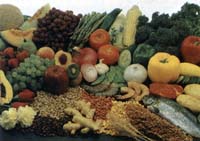 What happens to food after we eat it? Do our bodies use all the nutrients? Or a better question, “Can our bodies use all the nutrients?” Bioavailability of nutrients is about how the little bits of food e.g. vitamins, minerals, amino acids, fatty acids and simple sugars, are made available to our bodies for use.
What happens to food after we eat it? Do our bodies use all the nutrients? Or a better question, “Can our bodies use all the nutrients?” Bioavailability of nutrients is about how the little bits of food e.g. vitamins, minerals, amino acids, fatty acids and simple sugars, are made available to our bodies for use.
The quality of our diet depends on the nutrient content and the bioavailability of its nutrients. The bioavailability of nutrients, which can be defined simply as the efficiency of absorption and utilization or retention of the nutrients that are present in food, can vary substantially.
Bioavailability of nutrients is determined by
- nutrient content of the food,
- food processing,
- the physical state of the person,
- interactions among components of the diet,
- the presence of anti-nutritional factors.
Cultured Foods and Digestion
Cultured foods are processed by microorganisms. These foods have been in the diets of many different peoples all around the world for centuries. They were an accidental discovery of man that led him to be able to keep food for longer and make new types of foods and beverages. Slowly they have been replaced in many peoples’ diets by more processed and refined foods.
Cultured foods contribute to efficient digestion in three ways: by breaking down foods to make digestion and assimilation easier, by providing enzymes to aid digestion, and by supplying and nourishing the correct intestinal bacteria. What all cultured foods have in common is an abundance of lactic acid bacteria, yeasts, and moulds that produce enzymes which break down and alter the original foods.
A significant proportion of the body’s energy is involved in the digestion and transformation of food. In effect, these organisms predigest the foods, breaking down the complex proteins, carbohydrates and fats to more easily assimilable amino acids, fatty acids and simple sugars. This leads to more efficient assimilation and utilization of these nutrients and a reduced burden on the digestive tract. The action of the culture organisms makes the minerals in cultured foods more readily available to the body. The bacteria also produce B vitamins, providing a significant increase to the level of these vitamins in many cultured foods.
Enzymes
Perhaps even more important than these nutritional benefits is the effect of the actual bacteria and enzymes in cultured foods. These include many found in our own bodies, or very similar to them. There are more than 150,000 different types of enzymes in the human body and all functions of the body require them. The proteins, fats and carbohydrates in the food we eat must be broken down into simpler units to enable the body to absorb and utilize it. This is achieved by the action of specific enzymes.
Tasks Performed by Enzymes
- Storing surplus nutrients in the liver and muscles.
- Removing waste products from cells.
- Neutralising toxins and downgrading hormones in the liver.
- Building minerals into nerves, bones and blood.
- Breaking down other complex food particles into simpler units that can then be absorbed and utilized by the body.
Each enzyme has a specific purpose, so the deficiency or absence of even one can have quite serious effects. Foods such as fresh raw fruit in particular, but also fresh raw vegetables, grain foods and unpasteurised milk, contain enzymes. Food that is cooked or processed in any way generally has had its enzymes destroyed.
When food does contain enzymes, some of these can be used by our digestive system, and not just for digestion of the foods containing those enzymes. That is, enzyme-rich foods boost the body’s enzyme supply. Cultured foods are very rich in enzymes that are produced by the culture organisms and take part of the processes of fermentation. This means that eating cultured foods assists in the digestion of other foods by building up the enzyme supply.
References:
- Subcommittee on Nutrition and Diarrheal Diseases Control, Subcommittee on Diet, Physical Activity, and Pregnancy Outcome, Committee on International Nutrition Programs, Food and Nutrition Board, Institute of Medicine. 1992. Nutrition Issues in Developing Countries. Washington, D.C.: National Academy Press.
- Whitney, E.N. Rolfes S.R. 1993. Understanding Nutrition. West Publishing Company. MN.
- Zeffertt, Wendy. 1999. Cultured Foods. Hyland House Publishing Pty. Ltd.




